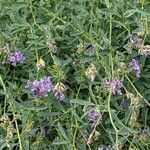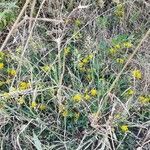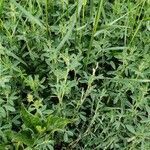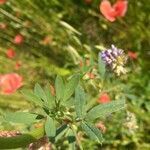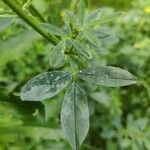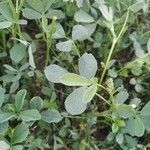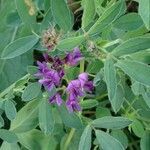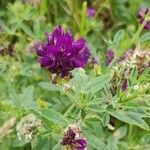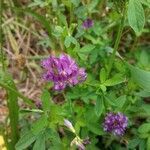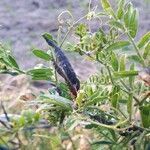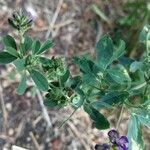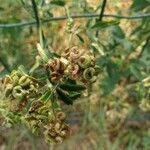Perennial herbs, 30-100 cm. Stems erect, ascending, rarely prostrate, quadrangular, glabrous or puberulent, much branched. Stipules ovate-lanceolate, base entire or with 1 or 2 denticles, apex acute; leaflets long ovate, obovate, to linear-ovate, (5-)10-25(-40) × 3-10 mm, papery, appressed pubescent abaxially, glabrous adaxially, lateral veins 8-10 pairs, base tapering, margin serrulate in upper 1/3, apex rounded, mucronate with a denticle from midrib. Heads or racemes with 5-30 flowers, 1-2.5 cm; peduncles straight, longer than leaves; bracts equal to pedicels, ca. 2 mm. Corolla variable in color, white, deep blue, to dark purple; standard oblong, retuse. Ovary linear; ovules numerous. Legume tightly coiled in 2-4(-6) spirals, 5-9 mm in diam., center solid or nearly so, brown when ripe, veins thin and inconspicuous. Seeds 10-20, yellow or brown, ovoid, 1-2.5 mm, smooth. Fl. May-Jul, fr. Jun-Oct.
Deep-rooted perennial with slender stems to 1 m; stipules lance-ovate, toothed; lfls oblanceolate or oblong to narrowly obovate, 1.5–3 cm, toothed at the summit; peduncles erect, about equaling the subtending lvs; heads subglobose to short-cylindric; fls 6–12 mm, on pedicels 2–3 mm; cal-lobes lance-linear, 1–3 mm, about equaling the tube; pod finely hairy; 2n=16, 32. June–Sept. A highly diversified species, with pronounced but confluent variation. The two subspecies characterized below are connected by a hybrid swarm called ssp. ×varia (Martyn) Arcang. Additional variants may be characterized in more detailed treatments.
Perennial herb, 0.3-0.8 m high; or stems prostrate; arising from stout rootstock; indumentum of simple appressed hairs. Central leaflets up to 25 x 15 mm, oblanceolate, margins serrate in upper part; midrib ending in terminal tooth. Stipules entire or irregularly toothed. Inflorescences 10-35-flowered racemes. Flowers 6-12 mm long. Petals: standard oblong; wings longer than keel. Flowering time Oct.-Feb. Pod coiled along full length, brown; smooth, veins emerging obliquely from ventral suture, branching somewhat, then anastomosing in outer part of coil face; many-seeded.
A herb. It is an erect or spreading legume. It grows to 80 cm high and spreads to 30-80 cm wide. It forms deep roots. It keeps growing from year to year. The stems are slender and hairy. The leaves are bluish green. The leaves have 3 leaflets like clover. The leaflets are oval or narrow. They are 3 cm long. The flowers are mauve. They appear in long stalked bunches. The fruit are small sickle shaped pods. The pods are deep brown. There are any named cultivated varieties.
Sprawling, sparsely hairy, perennial herb, stems up to 0.8 m long. Leaves 3-foliolate, leaflets obliquely narrowly oblong to obovate, minutely toothed on upper third, apex notched, minutely pointed. Flowers many, in an oblong raceme on peduncle 25-50 mm long, violet or purple. Pod 2-4-coiled, smooth, sparsely hairy, without spines.
